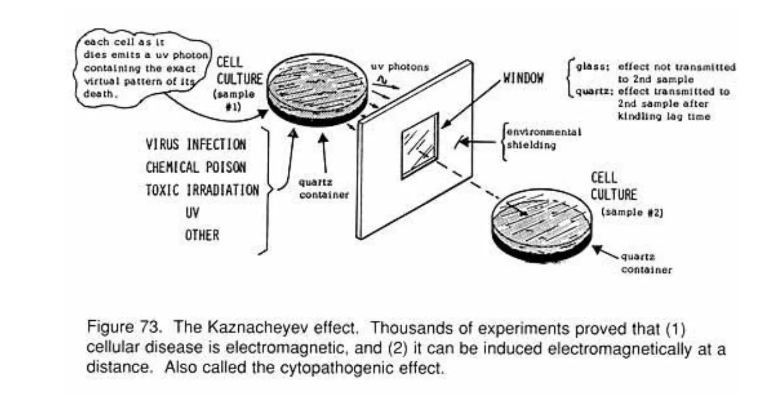
Introduction: Ever thought cells could communicate like a cell phone but with light? Enter the fascinating and controversial realm of the Kaznacheyev effect!
The Discovery: In the 1970s, a Russian scientist named Vlail Kaznacheyev, along with his colleagues, stumbled upon a phenomenon that would spark decades of debate. They observed that cells don’t go quietly into the night; instead, as they perish, they emit ultraviolet (UV) photons, like desperate SOS signals.
The Experiment: Kaznacheyev’s team placed two sets of cell cultures close to each other, separated only by a quartz barrier that let UV light pass through. When one set of cells was inflicted with doom (think viruses, toxins, or harmful radiation), these dying cells reportedly sent out UV light signals. The astonishing part? The neighboring cells, previously healthy, started showing signs of the same fate as if the light carried a morbid message.
The Twist: A glass barrier instead of quartz? The second set of cells remained unaffected, living their best cellular lives. It seemed that the UV light, with its mysterious cargo, couldn’t pass through glass, halting the transmission of the deadly message.
The Controversy: Dubbed the “cytopathogenic effect,” this phenomenon suggested something revolutionary—that diseases could potentially be transmitted electromagnetically. But here’s the catch: science thrives on replication, and the Kaznacheyev effect has been notoriously shy in other labs.
The Implications: If the effect is real, it could hint at an intricate bio-communication system and electromagnetic influences on health, a topic that’s gaining traction in today’s tech-filled world.
The Fun Fact: While the scientific jury is still out on the Kaznacheyev effect, it opens up a world of sci-fi-esque possibilities. Could our cells be gossiping about their demise? Are they warning their neighbors through a UV light group chat? The ideas are as intriguing as they are controversial.
Whether a quirk of experimental conditions or a genuine biological phenomenon, the Kaznacheyev effect reminds us that there are still mysteries within our own cells waiting to be understood. It’s a cellular conundrum that keeps the conversation glowing—quite literally!
Conclusion: Vlail Petrovich Kaznacheyev was a Russian biologist and a known figure in the field of biophysics. He is most recognized for his work related to the controversial phenomenon known as the Kaznacheyev effect, which he claimed to have discovered in the 1970s alongside his colleagues. According to his research, cells that were dying emitted ultraviolet (UV) photons, and these photons could transmit the “information” of cellular death to neighboring cells, causing similar effects in those cells if they were in quartz containers that allowed the passage of UV light. If a barrier that blocked UV light, such as glass, was used, the effect was not observed.
Regarding the proof to back up the Kaznacheyev effect, it’s important to note that this phenomenon has been met with skepticism within the scientific community. One of the main criticisms is the lack of independent replication of his results, which is a cornerstone of scientific validation. The experiments conducted by Kaznacheyev and his team were indeed numerous, but the methodology and the results were not widely accepted or reproduced by other researchers.
The idea that cells could communicate distress through electromagnetic signals, especially in the form of light, is certainly fascinating and has implications for our understanding of cellular processes and disease transmission. However, the evidence supporting the Kaznacheyev effect is not robust within the mainstream scientific literature.
There are fields of study such as bioelectromagnetics and biophotonics that explore the role of electromagnetic fields and light in biological processes, and some research within these disciplines has indicated that cells can emit light (biophotons) and that these emissions can vary with the state of the cell’s health. However, whether these emissions can induce pathological changes in other cells as described by the Kaznacheyev effect remains unconfirmed.